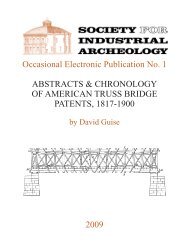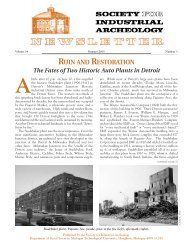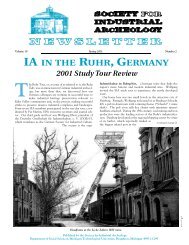birmingham, “pittsburgh of the south,” - Society for Industrial ...
birmingham, “pittsburgh of the south,” - Society for Industrial ...
birmingham, “pittsburgh of the south,” - Society for Industrial ...
Create successful ePaper yourself
Turn your PDF publications into a flip-book with our unique Google optimized e-Paper software.
Stonewall Quarry began operations in <strong>the</strong> early 1880s as part<br />
<strong>of</strong> an emerging limestone industry in Stonewall, Manitoba. The<br />
quarry industry was <strong>the</strong> vital mainstay <strong>of</strong> <strong>the</strong> local economy <strong>for</strong><br />
nearly a century. Depletion <strong>of</strong> usable limestone combined with<br />
economic factors to cause <strong>the</strong> quarry industry to shut down in<br />
1967. Mindful <strong>of</strong> <strong>the</strong> contribution quarrying had made to <strong>the</strong><br />
community’s history, <strong>the</strong> Town <strong>of</strong> Stonewall adapted <strong>the</strong> quarry<br />
property <strong>for</strong> use as a park, opened in 1985. The abandoned quarries<br />
and <strong>the</strong>ir towering limestone kilns have been trans<strong>for</strong>med<br />
into <strong>the</strong> centerpiece <strong>of</strong> an interpretive and recreational facility.<br />
The park’s interpretive area is built around a pot kiln built in <strong>the</strong><br />
early 1880s and three draw kilns built in 1904. The kilns were<br />
used to process limestone into quicklime. At present, all four<br />
kilns are deteriorating. The Town <strong>of</strong> Stonewall along with park<br />
staff are searching <strong>for</strong> ways to preserve and protect <strong>the</strong> kilns, and<br />
<strong>the</strong>y are seeking advice from SIA members who have had experience<br />
with similar sites. Info: Ca<strong>the</strong>rine Precourt, Stonewall<br />
Quarry Park, Box 250, Stonewall, Manitoba, Canada ROC 2ZO;<br />
(204) 467-5354; fax 467-5260; e-mail: stoneq@mb.sympatico.ca.<br />
Lime kilns (1904) at Stonewall Quarry Park, Stonewall,<br />
Manitoba.<br />
The 1999 Ironmasters Conference was held April 23-25, on<br />
<strong>the</strong> campus <strong>of</strong> West Virginia University. Cosponsored by <strong>the</strong><br />
Institute <strong>for</strong> <strong>the</strong> History <strong>of</strong> Technology and <strong>Industrial</strong> Archeology<br />
and <strong>the</strong> SIA Three Rivers Chapter, <strong>the</strong> three-day conference<br />
explored historic ironmaking and showcased West Virginia’s outstanding<br />
iron and steel heritage. On Friday morning 20 participated<br />
in an early bird tour <strong>of</strong> <strong>the</strong> Ohio Valley steel industry in <strong>the</strong><br />
Wheeling area. The first stop was Wheeling-LaBelle Nail Work,<br />
one <strong>of</strong> two remaining American cut-nail factories. Next was<br />
lunch at Wheeling’s West Virginia Independence Hall, <strong>the</strong> birthplace<br />
<strong>of</strong> West Virginia, a magnificent 1859 wrought and cast-iron<br />
frame building originally constructed as a U.S. Custom House.<br />
After lunch, <strong>the</strong> group headed across <strong>the</strong> Ohio River in a torrential<br />
downpour, bound <strong>for</strong> Wheeling-Pittsburgh Steel’s<br />
Steubenville South Works, better known as Mingo Junction. For<br />
many, this was <strong>the</strong> highlight <strong>of</strong> <strong>the</strong> day. In a marathon afternoon,<br />
we saw <strong>the</strong> basic oxygen furnace convert pig iron into steel, and<br />
<strong>the</strong>n followed <strong>the</strong> molten steel to <strong>the</strong> continuous caster, where it<br />
was cast into steel slabs. Completing <strong>the</strong> circuit, we toured <strong>the</strong><br />
rolling mill and watched as <strong>the</strong> thick slabs were reduced to coils<br />
<strong>of</strong> sheet steel. On Saturday morning, about 60 assembled <strong>for</strong> a<br />
day-long symposium. There were presentations on charcoal making,<br />
bloomeries, metallurgy, furnace documentation and interpre-<br />
NOTES & QUERIES<br />
tation, and big steel. Saturday evening, <strong>the</strong> ironmasters were<br />
treated to a reception and dinner, followed by a show-and-tell session.<br />
On a clear and chilly Sunday morning many conference<br />
attendees embarked on a driving tour <strong>of</strong> two <strong>of</strong> nor<strong>the</strong>rn West<br />
Virginia’s charcoal iron furnaces. The group first visited <strong>the</strong> 1854<br />
Virginia Furnace located near Albright, <strong>the</strong>n <strong>the</strong>y hiked down to<br />
<strong>the</strong> 1836 Henry Clay Iron Furnace at <strong>the</strong> Coopers Rock State<br />
Forest. After taking in <strong>the</strong> grand vista from <strong>the</strong> Coopers Rock<br />
Overlook, <strong>the</strong> conference ended and <strong>the</strong> ironmasters scattered to<br />
<strong>the</strong> four winds until next year. The 2000 Ironmasters Conference<br />
is scheduled <strong>for</strong> May 5-7 at Saugus, MA (see calendar <strong>for</strong> more<br />
info). [Editor’s note: thanks to Lee Maddex <strong>for</strong> turning in this report.]<br />
Historic Mining Walking Tour. Ruffner Mountain Nature<br />
Center (Birmingham, AL) is now <strong>of</strong>fering historic mining walking<br />
tours as a result <strong>of</strong> <strong>the</strong> research and participation <strong>of</strong> Jack<br />
Bergstresser [SIA], who assisted with a similar tour <strong>for</strong> <strong>the</strong> 1999<br />
SIA Fall Tour. Ruffner Mountain is part <strong>of</strong> Red Mountain where<br />
<strong>the</strong> statue <strong>of</strong> Vulcan stands. It was <strong>the</strong> site <strong>of</strong> iron mines from <strong>the</strong><br />
1860s to <strong>the</strong> 1960s. Significant material remains <strong>of</strong> <strong>the</strong> mines and<br />
<strong>the</strong> mining landscape remain <strong>for</strong> interpretation. Jack’s tours have<br />
been so well received that Bill Griffin, a local resident and photographer,<br />
felt inspired to report to <strong>the</strong> SIA. He writes that “<strong>the</strong><br />
tour group was moved by Jack’s description <strong>of</strong> <strong>the</strong> miners’ lives.<br />
We came to realize that Birmingham’s industrial reputation was<br />
built on <strong>the</strong> foundation <strong>of</strong> dedication, hard work, and sacrifice <strong>of</strong><br />
<strong>the</strong> miners.<strong>”</strong> Info: Ruffner Mountain Nature Center, 1214 81st<br />
St. South, Birmingham, AL 35206; (205) 833-8264 M-F; 833-<br />
8112 weekends. The nature center welcomes volunteers and<br />
donations <strong>for</strong> its programs.<br />
Ruffner Mountain tour group pauses to contemplate an ore crusher.<br />
10th International Symposium on Molinology. For <strong>the</strong><br />
first time <strong>the</strong> symposium will be coming to <strong>the</strong> Western<br />
Hemisphere when its participants ga<strong>the</strong>r at Strat<strong>for</strong>d, VA, <strong>for</strong> <strong>the</strong><br />
Sept. 16-24 event. Molinology is <strong>the</strong> study <strong>of</strong> wind-, water-, and<br />
animal-powered mills. This symposium is <strong>the</strong> quadrennial meeting<br />
<strong>for</strong> The International Molinological <strong>Society</strong> (TIMS), and it<br />
generally takes place in Europe. Scholars, historic preservationists,<br />
and mill owners/millers meet <strong>for</strong> presentations on <strong>the</strong> application<br />
<strong>of</strong> <strong>the</strong> natural <strong>for</strong>ces <strong>of</strong> power to human work. The weeklong<br />
meetings combine <strong>for</strong>mal presentations with visits to historic<br />
mills. Participants come from all parts <strong>of</strong> <strong>the</strong> world, though <strong>the</strong><br />
presentations are in English. Membership in TIMS is a require-<br />
18 <strong>Society</strong> <strong>for</strong> <strong>Industrial</strong> Archeology Newsletter, Vol.28, No. 4, Winter 1999<br />
Bill Griffin photo






